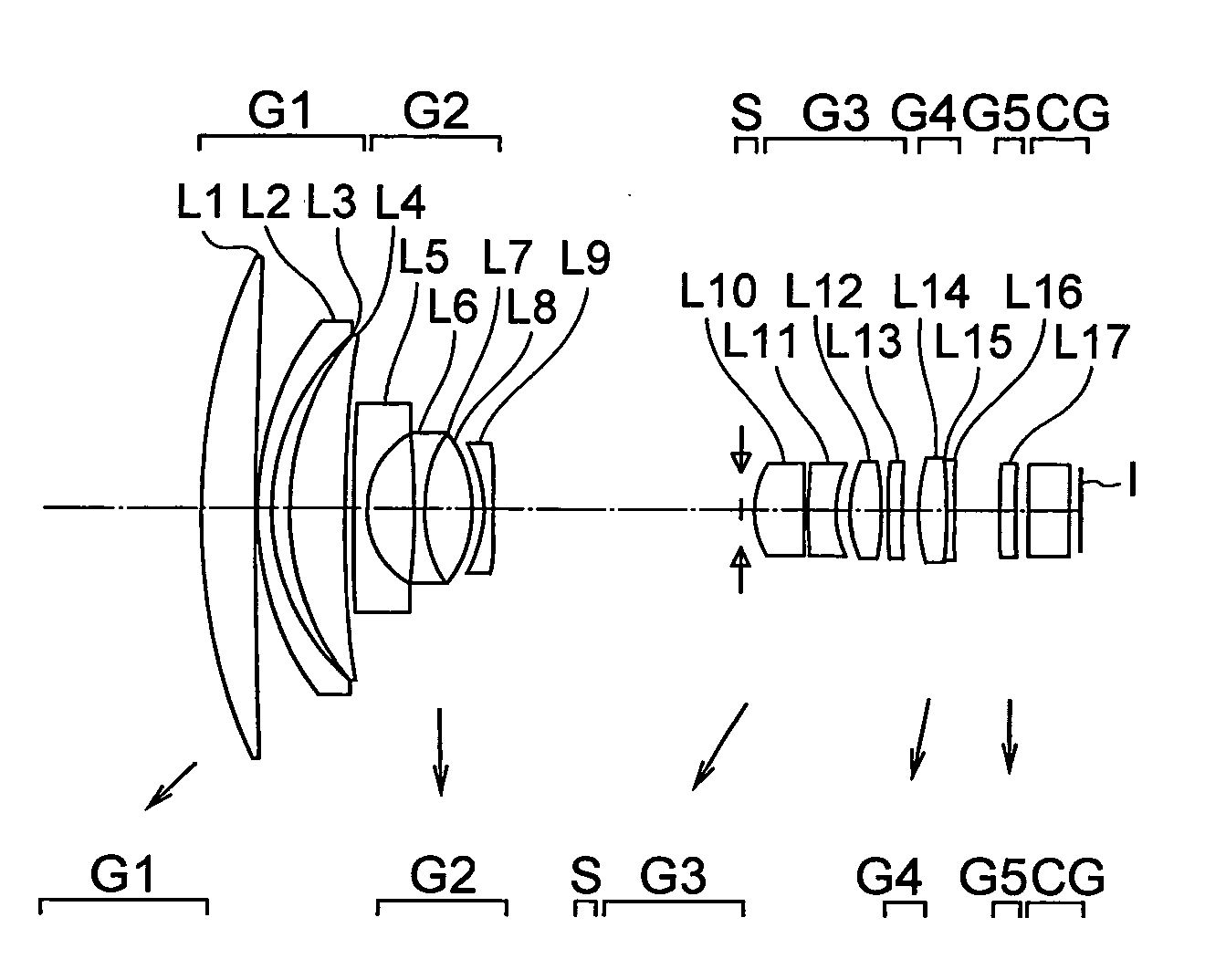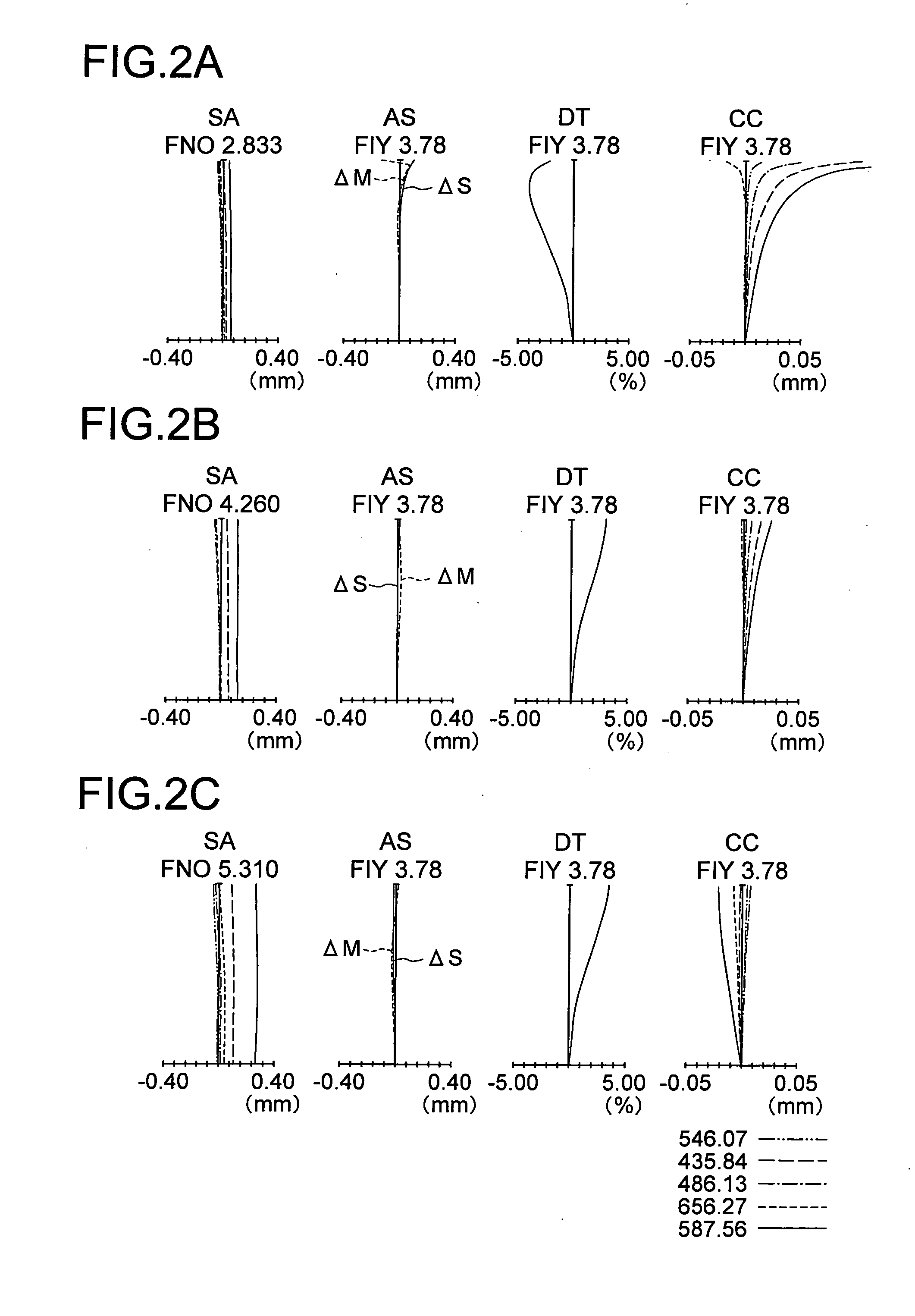Image forming optical system and electronic image pickup apparatus using with the same
- Summary
- Abstract
- Description
- Claims
- Application Information
AI Technical Summary
Benefits of technology
Problems solved by technology
Method used
Image
Examples
example 1
[0304]
unit mmSurface dataSurface no.rdndνdeffective radiusObject plane∞∞ 160.9825.351.6485053.0224.00 2495.7440.1923.38 331.1721.281.9228618.9017.70 422.2271.771.6338723.3816.35 526.8775.231.4970081.5416.31 6101.913Variable16.00 7303.8141.101.8830040.769.68 88.3124.796.82 9−46.2540.801.8830040.766.711012.3960.011.5140042.836.691112.3964.871.7847225.686.6912−12.6841.156.7213−11.4990.801.7725049.605.7214*−230.432Variable5.7215 (stop)∞1.303.3916*10.7434.931.5891361.143.9617−78.0510.104.061828.0412.771.8466623.784.071910.2951.423.872012.8263.121.4970081.544.2121−36.9850.644.2922*39.2071.361.5307155.694.2923*33.196Variable4.282419.1302.681.4970081.544.6025−119.0900.011.5140042.834.4726−119.0900.821.8040046.574.472776.031Variable4.4128*147.3741.631.5307155.694.1729*−67.9391.094.0930∞4.001.5168064.204.0231∞1.053.85Image plane∞Aspherical surface data14th surfaceK = 0.000, A2 = 0.0000E+00, A4 = −7.99095e−05, A6 = −9.37486e−07,A8 = 4.32991e−08, A10 = −1.00218e−0916th surfaceK = 0.000, A2 = 0....
example 2
[0305]
unit mmSurface dataSurface no.rdndνdeffective radiusObject plane∞∞ 159.9634.201.4970081.5418.60 22486.1420.1017.76 341.7000.991.8466623.7815.50 425.3670.721.6338723.3814.76 528.6404.191.6779055.3414.74 6111.334Variable14.50 7110.4221.101.8830040.769.11 88.0834.796.49 9−46.2540.801.8830040.766.241012.3960.011.5140042.836.101112.3964.871.7847225.686.1112−12.6841.156.0713−11.4990.801.7725049.605.0814*−125.405Variable5.0015 (stop)∞1.303.4816*10.7434.931.5891361.144.0717−78.0510.104.161828.0412.771.8466623.784.161910.4691.423.942013.6113.121.4970081.544.2521−36.9850.644.3322*63.8681.361.5307155.694.3323*48.855Variable4.342419.1302.681.4970081.544.6525−119.0900.011.5140042.834.5126−119.0900.821.8040046.574.512776.031Variable4.4628*147.3741.631.5307155.694.2129*−67.9391.094.1830∞4.001.5168064.204.0931∞1.053.86Image plane∞Aspherical surface data14th surfaceK = 0.000, A2 = 0.0000E+00, A4 = −8.14579e−05, A6 = −1.15665e−06,A8 = 6.76342e−08, A10 = −1.49231e−0916th surfaceK = 0.000, A2 = 0...
example 3
[0306]
unit mmSurface dataSurface no.rdndνdeffective radiusObject plane∞∞ 160.5783.831.4970081.5418.70 21959.8630.1018.64 344.6001.011.8211424.0615.50 424.5340.781.6700020.0014.71 527.7674.491.6935053.2114.69 6126.235Variable14.45 7139.9911.101.8830040.769.75 88.4674.796.96 9−46.2540.801.8830040.766.871012.3960.011.5140042.836.851112.3964.871.7847225.686.8612−12.6841.156.8813−11.4990.801.7725049.605.8014*−133.624Variable5.7915 (stop)∞1.303.4816*10.7434.931.5891361.144.0317−78.0510.104.091828.0412.771.8466623.784.081910.4941.423.852013.5843.121.4970081.544.1321−36.9850.644.1922*90.1591.361.5307155.694.1823*47.692Variable4.192419.1302.681.4970081.544.6525−119.0900.011.5140042.834.5226−119.0900.821.8040046.574.522776.031Variable4.4728*147.3741.631.5307155.694.2029*−67.9391.094.2230∞4.001.5168064.204.1131∞0.973.87Image plane∞Aspherical surface data14th surfaceK = 0.000, A2 = 0.0000E+00, A4 = −7.27292e−05, A6 = −1.76848e−06,A8 = 1.00411e−07, A10 = −1.83590e−0916th surfaceK = 0.000, A2 = 0...
PUM
 Login to View More
Login to View More Abstract
Description
Claims
Application Information
 Login to View More
Login to View More - R&D
- Intellectual Property
- Life Sciences
- Materials
- Tech Scout
- Unparalleled Data Quality
- Higher Quality Content
- 60% Fewer Hallucinations
Browse by: Latest US Patents, China's latest patents, Technical Efficacy Thesaurus, Application Domain, Technology Topic, Popular Technical Reports.
© 2025 PatSnap. All rights reserved.Legal|Privacy policy|Modern Slavery Act Transparency Statement|Sitemap|About US| Contact US: help@patsnap.com



